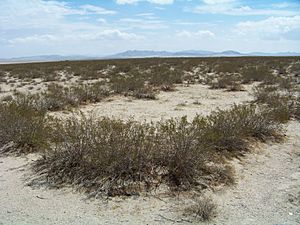King Clone facts for kids
King Clone is a very special creosote bush in the Mojave Desert. It is believed to be the oldest creosote bush ring in the world. Scientists think this plant is about 11,700 years old. This makes it one of the oldest living things on Earth!
King Clone is not just one bush. It's a huge circle of bushes that are all connected underground. This is called a clonal colony. All the plants in the ring are genetically identical, meaning they are all part of the same original plant. The entire ring can be up to 67 feet (20 meters) wide. Its average width is about 45 feet (14 meters).
Contents
Where to Find King Clone
The King Clone ring is located in the central Mojave Desert in California. It is near the towns of Lucerne Valley and Landers. This special plant lives in a protected area called the Creosote Rings Preserve. This land is not open to the public to help keep the plant safe.
How Scientists Figured Out Its Age
Discovering King Clone's Age
A professor named Frank Vasek from the University of California, Riverside first found King Clone. He also figured out how old it was. Professor Vasek thought that all the bushes in the ring were actually one single organism.
Proving It's One Plant
A student named Leonel da Silveira Lobo O'Reilly Sternberg helped prove this idea. He showed that plants inside the ring were more alike than plants from other groups. This meant they were all part of the same plant.
Two Ways to Date the Plant
Professor Vasek used two main methods to estimate the plant's age:
- Counting Growth Rings: He looked at the growth rings in the wood, similar to how you count rings in a tree trunk. He also measured how much the plant grew each year.
- Radiocarbon Dating: He used radiocarbon dating on old pieces of wood found in the center of the ring. This method measures how much carbon-14 is left in a sample to tell its age.
Both methods gave similar results, showing the plant was about 11,700 years old.
King Clone in the Spotlight
This ancient plant has been featured in several TV shows.
- In 1983, King Clone appeared on an episode of Ripley's Believe It Or Not.
- More recently, in 2022, the famous naturalist David Attenborough visited King Clone for his TV series The Green Planet. He had actually filmed the plant before, in 1982, for his series The Living Planet. Over 40 years, the plant had grown less than one inch (25 mm)! This shows how slowly it grows.
See also
 In Spanish: King Clone para niños
In Spanish: King Clone para niños
- List of oldest trees
- Fairy ring


